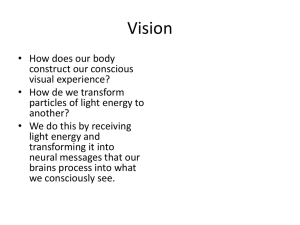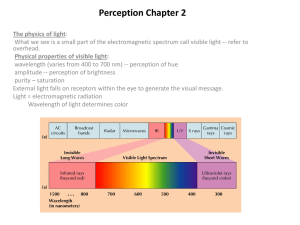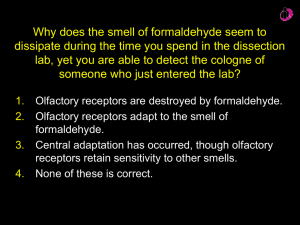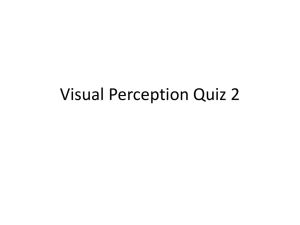Anatomy and Physiology of the Retina
advertisement
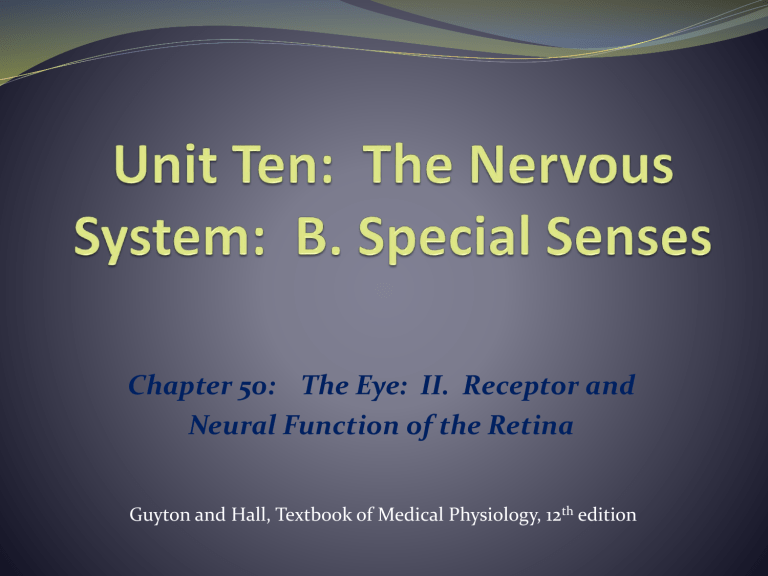
Chapter 50: The Eye: II. Receptor and Neural Function of the Retina Guyton and Hall, Textbook of Medical Physiology, 12th edition Anatomy and Physiology of the Retina • Layers of the Retina-functional components arranged in layers from the outside to the inside a. Pigmented layer b. Layer of rods and cones c. Outer nuclear layer containing the cell bodies of the rods and cones d. Outer plexiform layer e. Inner nuclear layer f. Inner plexiform layer g. Ganglionic layer h. Layer of optic nerve fibers i. Inner limiting membrane Anatomy and Physiology of the Retina • Layers of the Retina Fig. 50.1 Layers of the retina Anatomy and Physiology of the Retina • Fovea- minute area in the center of the retina (1 sq mm) capable of acute vision; contains only cones • Rods and Cones- the major functional segments of either a rod or cone are: a. b. c. d. The outer segment The inner segment The nucleus The synaptic body Anatomy and Physiology of the Retina Fig. 50.3 Schematic drawing of the functional parts of the rods and cones Anatomy and Physiology of the Retina • Rods and Cones a. Light sensitive photochemicals are found in the outer segment b. In rods, it is rhodopsin c. In cones, it is one of three color pigments which function exactly like rhodopsin Anatomy and Physiology of the Retina • Rods and Cones d. In the outer segments of both rods and cones are large numbers of discs (as many as 1000 per rod or cone) e. Pigments are conjugated proteins incorporated into the membranes of the discs f. Inner segment contains the usual organelles and cytoplasm Anatomy and Physiology of the Retina • Rods and Cones g. Synaptic body connects with the neuronal cells, the horizontal and bipolar cells • Pigment Layer of the Retina a. Melanin prevents light refraction throughout the eyeball b. Stores large quantities of vitamin A Anatomy and Physiology of the Retina • Pigment Layer of the Retina c. Vitamin A is an important precursor of the photosensitive chemicals of rods and cones Anatomy and Physiology of the Retina Fig. 50.4 Membranuous structures of t he outer segments of a rod and cone Anatomy and Physiology of the Retina • Blood Supply of the Retina a. Central retinal artery enters with the optic nerve b. Branches to supply the entire retinal surface c. Outermost layer is adherent to the choroid which is also a highly vascular area Photochemistry of Vision • Rhodopsin-Retinal Visual Cycle Fig. 50.5 Rhodopsin-retinal visual cycle in the rod Photochemistry of Vision • Rhodopsin-Retinal Visual Cycle-The Decomposition by Light Energy a. When light energy is absorbed by rhodopsin, the rhodopsin begins to decompose; b. The cause of this is photoactivation of electrons in the retinal portion of rhodopsin, which converts cis into a trans form and cannot bind to the active site on the protein. c. This leads to unstable intermediates Photochemistry of Vision • Reformation of Rhodopsin a. First step is re-convert to cis form of retinal b. Requires energy and is catalyzed by retinal isomerase c. Once formed it binds to the protein and is stable Photochemistry of Vision • Role of Vitamin A a. Second pathway converts the trans-retinal to trans-retinol (one form of vitamin A) b. The trans-retinol is then converted to cis-retinal c. Vitamin A is present in the pigment layer of the retina and in the cytoplasm of rods d. Excess retinal is converted to vitamin A Photochemistry of Vision • Excitation of the Rod When Rhodopsin is Activated by Light a. The rod receptor potential is hyperpolarizing, not depolarizing b. When rhodopsin decomposes, it decreases the rod membrane conductance for sodium ions in the outer segment of the rod c. This causes hyperpolarization of the entire rod membrane Photochemistry of Vision Fig. 50.6 Movement of sodium and potassium ions through the inner and outer segments of the rod Photochemistry of Vision Fig. 50.7 Phototransduction in the outer segment of the photoreceptor membrane Photochemistry of Vision • Duration of the Receptor Potential and Log Relation of the Receptor Potential to Light Intensity a. Receptor potential occurs in 0.3 seconds and lasts for about 1 second in the rods b. In the cones it occurs four times as fast c. Receptor potential is approx. proportional to the logarithm of the light intensity which allows the eye to discriminate light intensities through a range many thousand times as great as would be otherwise Photochemistry of Vision • Mechanism by Which Rhodopsin Decomposition Decreases Membrane Sodium Conductance (Excitation Cascade) a. Photon activates an electron in the cis-retinal portion of rhodopsin and leads to the formation of metarhodopsin b. Activated rhodopsin acts as an enzyme to activate many molecules of transducin c. Activated transducin activates many mcles of phosphodiesterase Photochemistry of Vision • Mechanism by Which Rhodopsin Decomposition Decreases Membrane Sodium Conductance (Excitation Cascade) d. Activated phosphodiesterase hydrolyzes cGMP which allows the sodium channels to close e. Within a second, rhopdopsin kinase inactivates metarhodopsin and reversion back to the normal state with open sodium channels Photochemistry of Vision • Photochemistry of Color Vision by the Cones a. Only one of three types of color pigments is present in each of the different cones b. Color pigments are blue, green, and red sensitive pigments Photochemistry of Vision Fig. 50.8 Light absorption by the pigment of the rods and the three color receptive cones Photochemistry of Vision • Automatic Regulation of Retinal Sensitivity a. Light Adaptation- in bright light the concentrations of photosensitive chemicals are reduced b. Dark Adaptation- in darkness, the retinal and opsins are converted back into the light sensitive pigments Photochemistry of Vision Fig. 50.9 Dark adaptation, demonstrating he relation of cone adaptation to rod adaptation Photochemistry of Vision • Other Mechanisms of Light and Dark Adaptation a. Change in pupillary size b. Neural adaptation Color Vision • Tricolor Mechanism of Color Detection a. Spectral sensitivities of the three types of cones b. Interpretation of color in the Nervous System Fig. 50.10 Demonstration of the degree of stimulation of the different color sensitive cones by monochromatic lights of four colors: blue, green, yellow, and orange Color Vision • Perception of White Light- equal stimulation of the red, green, and blue cones gives the sensation of seeing white • Color Blindness- when a single group of cones is missing, the person is unable to distinguish some colors from others a. Red-green b. Blue weakness Neural Function of the Retina Fig. 50.12 Neural organization of the retina; peripheral area to the left, foveal area to the right Neural Function of the Retina • Neural Circuitry of the Retina a. Photoreceptors transmit signals to the outer plexiform layer where they synapse with bipolar cells and horizaontal cells b. Horizontal cells which transmit signals horizontally in the outer plexiform layer from the rods and cones to bipolar cells c. Bipolar cells which transmit signals vertically to the inner plexiform layer, where they synapse with ganglion cells and amacrine cells Neural Function of the Retina • Neural Circuitry of the Retina d. Amacrine cells transmit signals either directly from bipolar cells to ganglion cells or horizontally from axons of the bipolar cells to dendrites of the ganglion cells or other amacrine cells e. Ganglion cells which transmit output signals from the retina through the optic nerve into the brain Neural Function of the Retina • Visual Pathway from the Cones to the Ganglion Cells Functions Differently from the Rod Pathway a. (Fig. 50.12) Visual pathway from the fovea has three neurons in a direct pathway: cones, bipolar cells, and ganglion cells b. For rod vision there are four neurons in the direct pathway: rods, bipolar cells, amacrine cells, and ganglion cells Neural Function of the Retina • Neurotransmitters a. Rods and cones release glutamate b. Amacrine cells release: GABA, glucine, dopamine, acetylcholine, and indolamine; all of which are inhibitory • Transmission of Most Signals Occurs in the Retinal Neurons by Electrtonic Conduction, Not by Aps- direct flow of electric current in the neuronal cytoplasm and nerve axons from the point of excitation all the way to the output synapses Neural Function of the Retina • Lateral Inhibition- enhances visual contrast and is a function of the horizontal cells Fig. 50.13 Excitation and inhibition of a retinal area caused by a beam of light Neural Function of the Retina • Excitation and Inhibition- two sets of bipolar cells provide opposing and inhibitory signals in the visual pathway a. Depolarizing bipolar cells b. Hyperpolarizing bipolar cells Neural Function of the Retina • Amacrine Cells and Their Functions- 30 types identified and the functions of 6 have been characterized a. b. c. d. Part of the direct pathway for rod vision Responds strongly at the onset Responds to changes in illumination Movement of a spot across the retina Neural Function of the Retina • Ganglion Cells and Optic Nerve Fibers a. 100 million rods, 3 million cones, and 1.6 million ganglion cells (60 rods and 2 cones converge on an individual ganglion cell) b. Central fovea has 35,000 cones and no rods c. Greater sensitivity of the peripheral retina to weak light d. Rods are 30-300x more sensitive to light than cones; 200 rods converge on a fiber in the periphery Neural Function of the Retina • Excitation of the Ganglion Cells a. Spontaneous continuous APs in the ganglion cells b. Transmission of changes in light intensity- the off-on response Fig. 50.14 Responses of a ganglion to light Neural Function of the Retina • Transmission of Signals Depicting Contrasts in the Visual Scene: The Role of Lateral Inhibition Fig. 50.15 Neural Function of the Retina • Transmission of Color Signals by the Ganglion Cells a. Single ganglion may be stimulated by several cones or by only a few b. Some cells may be stimulated by one type but inhibited by another c. Importance of color contrast mechanisms is that the retina itself begins to differentiate colors

